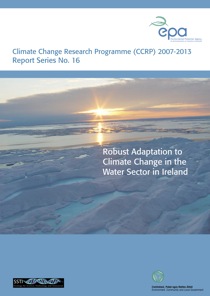CCRP16 - Robust Adaptation to Climate Change in the Water Sector in Ireland
Summary: Adaptation is necessary to position Ireland to better cope with the impacts of climate change. This report develops a framework for supporting adaptation to climate change and a tool for assessing adaptation options.

Adaptation is necessary to position Ireland to better cope with the impacts of climate change. Impact studies to date have identified some strong climate signals, including an increase in river flows during winter and spring, along with reductions in late summer and autumn, with simulated changes becoming more pronounced by the middle and end of this century. For water supply management, the characteristics of the water supply system will have a strong bearing on vulnerability to climate change. Where there is adequate excess capacity, even a large change in climate may have limited effect. However, where a system is operating at, or close to, capacity even a small change in climate has the potential to tip the system past a critical threshold. Adaptation in the water sector is challenging where there is uncertainty in the magnitude of climate impacts, infrastructure is expensive and has a long lead time in terms of the planning and construction time required, has a long design life and is expected to function in present and future climate conditions. These challenges are coupled with tightened financial resources.
This report develops a framework for supporting adaptation to climate change and a tool for assessing adaptation options. The framework established is built on the identification of vulnerability for individual surface water abstraction points. Vulnerability is
highlighted where climate change is likely to alter the availability of water to meet demands at that point. Isuch situations, an adaptation tool is developed to identify and appraise adaptation options that are robust to uncertainty in future climate. The tool developed is intended as an exploratory tool to identify where and when adaptation will be necessary and to identify if certain strategies are likely to be successful under the range of likely future conditions. It is flexible in that it can be applied to individual existing or new abstraction points or to entire catchments, can be readily updated when revised climate change
information becomes available and allows the integration of different pressures.